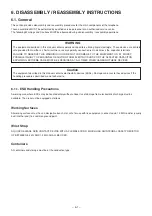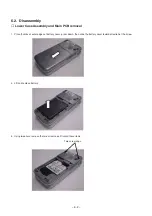
– 7-2 –
7.3. Lead Free (PbF) solder
CAUTION
The Printed Circuit Board (PCB) used in this telephone has been manufactured using Lead Free solder.
Lead Free solder has a higher melting point than Lead solder - typically 30 - 40
°
C higher. Always use a high temperature
soldering iron When using a soldering iron with temperature control, it should be set to 370
±
10
°
C (700
±
20
°
F).
When using lead solder, all PbF solder must be removed from the solder area. Where this is not possible, heat the PbF
solder until it melts before applying lead solder.
Avoid overheating PbF solder as it has a tendency to splash at temperatures above 600
°
C (1100
°
F).
Re-flowing / Re-touching
1. Re-touching by soldering iron:
HAKKO 928 soldering iron is recommended.
900S-T-B tip for thicker solder joints and 900M-T-LB tip for thinner solder joints are recommended.
2. Tip temperature/time
Normal pad: 325
±
10
°
C, less than five seconds
Large Pad: 400
±
10
°
C, less than five seconds
3. Pressure at solder tip
8
Weight of soldering iron, (50gm) + 100gm to 150gm
8
Do not exert pressure in the horizontal direction
4. Retouching small components
Pinch the component using two soldering irons and retouch within four seconds.
Note:
To avoid land detachment, do NOT apply excessive force on the soldering iron when heating the board. Ensure that the
solder has melted sufficiently to allow component removal without damaging the board.
















































